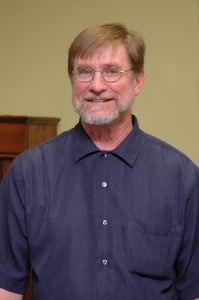Another Writing Lesson from the Cemetery—Revision: Getting it Right

Early in the second summer I worked at Mt. Hope, we buried a woman on a Saturday. Monday morning first thing, a taxicab entered the main gate and proceeded to West Memorial, an older section fringed in sycamore and pines. A short, heavyset man in flip-flops, shorts, and a Hawaiian shirt paid the driver and found a bench close to Saturday’s grave. We on the crew assumed him to be the widower, visiting his wife. He sat on the bench throughout the day, adjusting himself occasionally. He ate a sack lunch. He took off his shirt for a time to reveal a huge rounded belly, took off his hat to expose his baldness. The taxi returned for him at 4:30, around our quitting time.
“Buddha’s back,” Les said the next morning as we were preparing our mowers. “Skip West Memorial for the day.”
We mowed the other sections, and trimmed headstones, keeping the old man in sight. At the end of the day, the taxi came and he was gone. By the end of the week, I noticed that Les, who lived on the cemetery grounds, had mowed West Memorial after hours. Not that the grass ever grew well there, shaded as it was by a thick line of pines.
After two weeks of sitting on the bench, the widower walked slowly to the cemetery office and said that his wife wasn’t happy. She wanted to be somewhere else. “She always liked grass,” he told the assistant manager.
The next day, we went to the veterans’ section, a sunny, grassy place, to a plot approved by the widower. We removed the sod, and Don started digging. He scooped some of the dirt into a trailer to take down to West Memorial and kept the rest in a mound close to the grave. The process was not elaborate as a preparation for a funeral—we didn’t have to pitch a tent, set up chairs, or cover dirt with artificial grass. When the hole was open, Don wheeled down to the original grave, where, again, we cut sod and started digging. This was more difficult. The coffin, of course, was sealed in a concrete vault, and we had to take care not to crush its thin walls. As a result, the hole to remove the vault had to be cut longer and wider than the original grave, enough that Don could lower the backhoe bucket deep and wide enough to use it as a prying tool. We went down in, a boy on each side, each with a chain, one to the head of the vault, one to the foot. Already, moisture had begun to seep into the vault, and the work was slimy. Don lifted one end of the vault just high enough for one of us to slide a chain under, then did the same with the other end. We secured each chain at the top of the vault, then wove the chains, top and bottom together, and Don gently lifted the vault into the air. The crew held it to prevent unsteady swinging.
Don drove the backhoe, cargo suspended from the bucket, crawling toward the veterans’ section, where he lowered the vault into the new grave, and we filled around it, above it, tamped it down, then re-laid the sod. One of us watered the sod while the rest of the crew went down to fill the gaping hole in West Memorial. We wanted the interrupted earth and patchy grass to look as it had before, just as we wanted the new grave in veterans’ to blend in with the smooth grass of that section. “Buddha,” as we’d come to call him, did not witness the transfer, encouraged by the cemetery managers, we found out later, to stay home.
The next day, the taxi cab dropped him off, he sat on a bench, he ate lunch, he took his shirt off midway through the afternoon to sun himself, and he left at 4:30. He visited for a week before he trudged up to the main office. His wife could not rest peacefully. “The gas meter,” he said, “behind the Veteran’s Wall, ticks. It bothers her.”
Her next plot was in Whispering Pines. Grass, no gas meter, nearby bench. Same transfer, a little wetter, a little slimier, a hint of smell beginning to permeate our nostrils. Again, the widower did not witness the transplant. One of the crew said we should have just cut the sod and laid it back down, watered it, and told him she was there. An easy fiction, perhaps, but wrong. We weren’t pleasing ourselves, we were pleasing the widower. So we did it right, no shortcuts, honest and dirty work.
“Buddha” seemed pleased the next day, and for a week after. Then, nearly a month after his wife’s funeral, he stopped coming to the cemetery. Sure, he sometimes left flowers—on her birthday (we knew it from her tombstone, when that arrived and we placed at the head of the grave), and on Memorial Day the next year, and on a mid-June day we suspected might be their wedding anniversary. But he had found the right plot for her, finally, and ameliorated the intensity of his grief.
When I was working at the cemetery, and for some time after, I found his story odd, weird, mystifying. Comical, even. I’d tell it to people as someone might tell a party joke. Since then, though, I’ve gained respect for that widower we nicknamed “Buddha.” He had a serious problem—his grief—to get through, and he stuck with it until he worked through it, not caring what others thought. As a writer, I’ve learned the importance of revision. Good writers simply cannot live with something that is a poor imitation of what they have imagined as their story, their characters, their attempts toward meaning. They enjoy sitting with, or on, the work, weighing its success. This success is not a matter of evaluation or approval; it is more about acceptance, about becoming comfortable with, becoming sure of, the work. The writer thinks about what the work wants, even if that work is not “real,” just as that widower thought about what his dead wife might want, even though she was no longer alive. And the writer works at the task with great effort, spending days digging up and resettling the plot, the characters, the metaphors, and the language. In the end, no one should be able to see all that work. A reader never knows how much effort has been spent on any poem, essay, story, or novel. A writer sometimes writes a first draft that needs hardly any work at all. The same writer might take several years, and twenty drafts, before another work settles into its destined iteration.
Revision is believing that the task can be accomplished—with work, care, and sensitivity. The best writers will tell you that revision is their favorite part of writing, more satisfying than writing a first draft. They will tell you that when they’ve carefully done that work, they can let the work stand on its own, they can leave the cemetery, and let what they’ve accomplished rest in peace—not dead, but fully alive.
Illustration by Matt Manley. Matt has been working as a freelance illustrator for over twenty years. His illustration is primarily figurative and symbolic with surrealist leanings, and past client work includes editorial, corporate, medical, book, and higher education. Though in the end his work is technically digital collage, the process integrates both traditional and digital media. Collage elements are original oil paintings and drawings, with occasional scanned found objects and photos added to the mix, all united in Photoshop .
Recommended
Nor’easter
Post-Op Appointment With My Father
Cedar Valley Youth Poet Laureate | Fall 2024 Workshop






